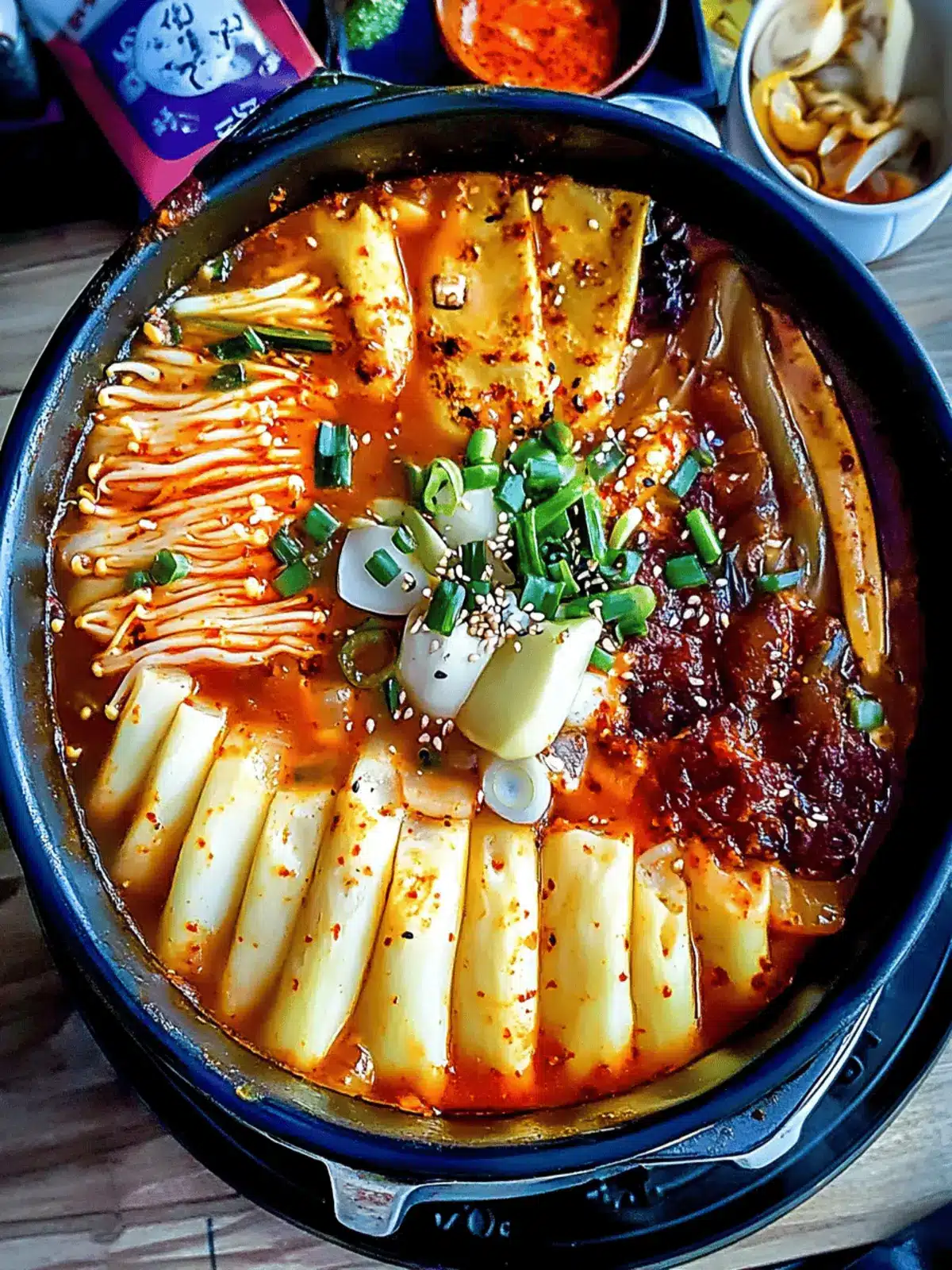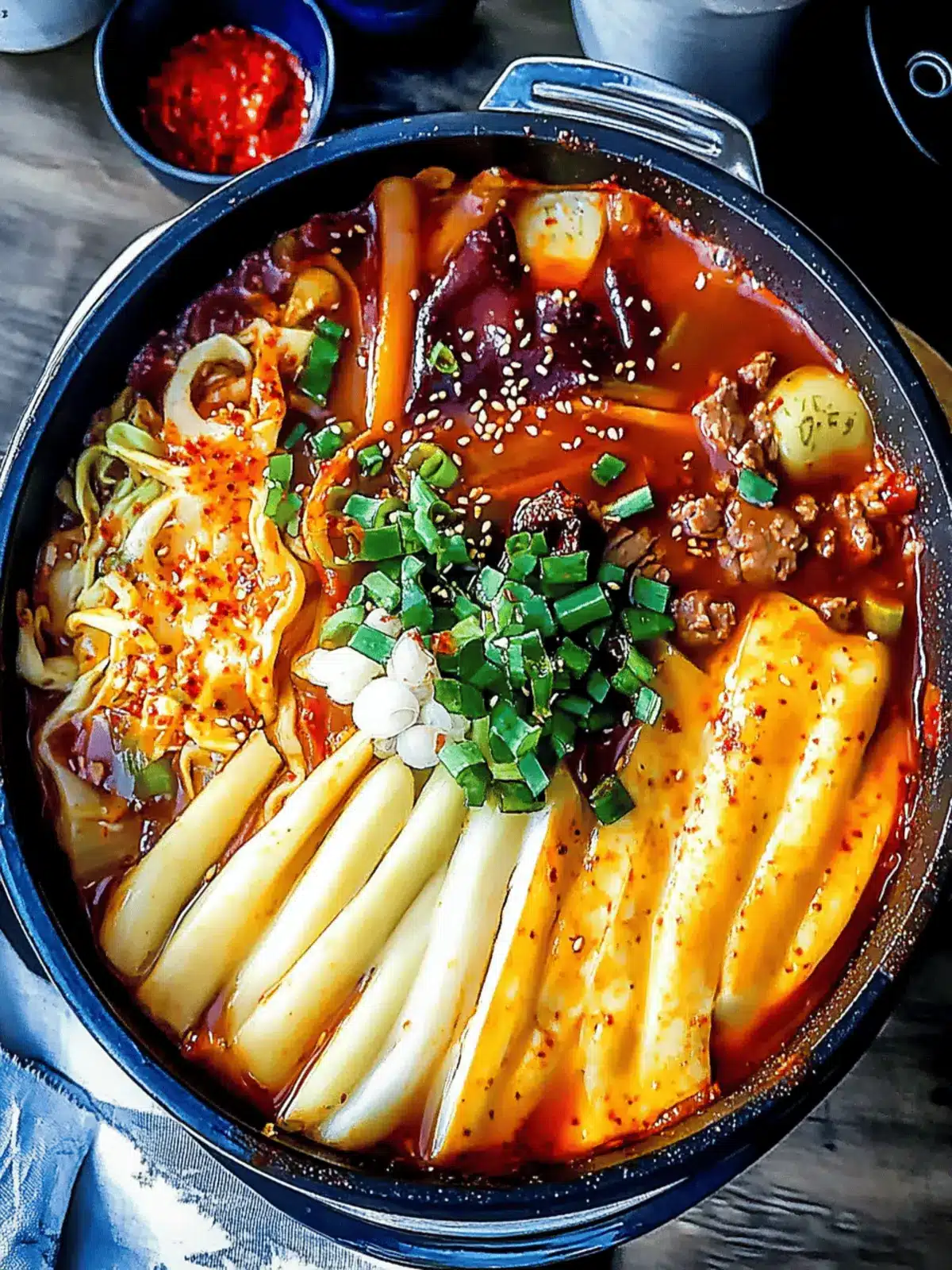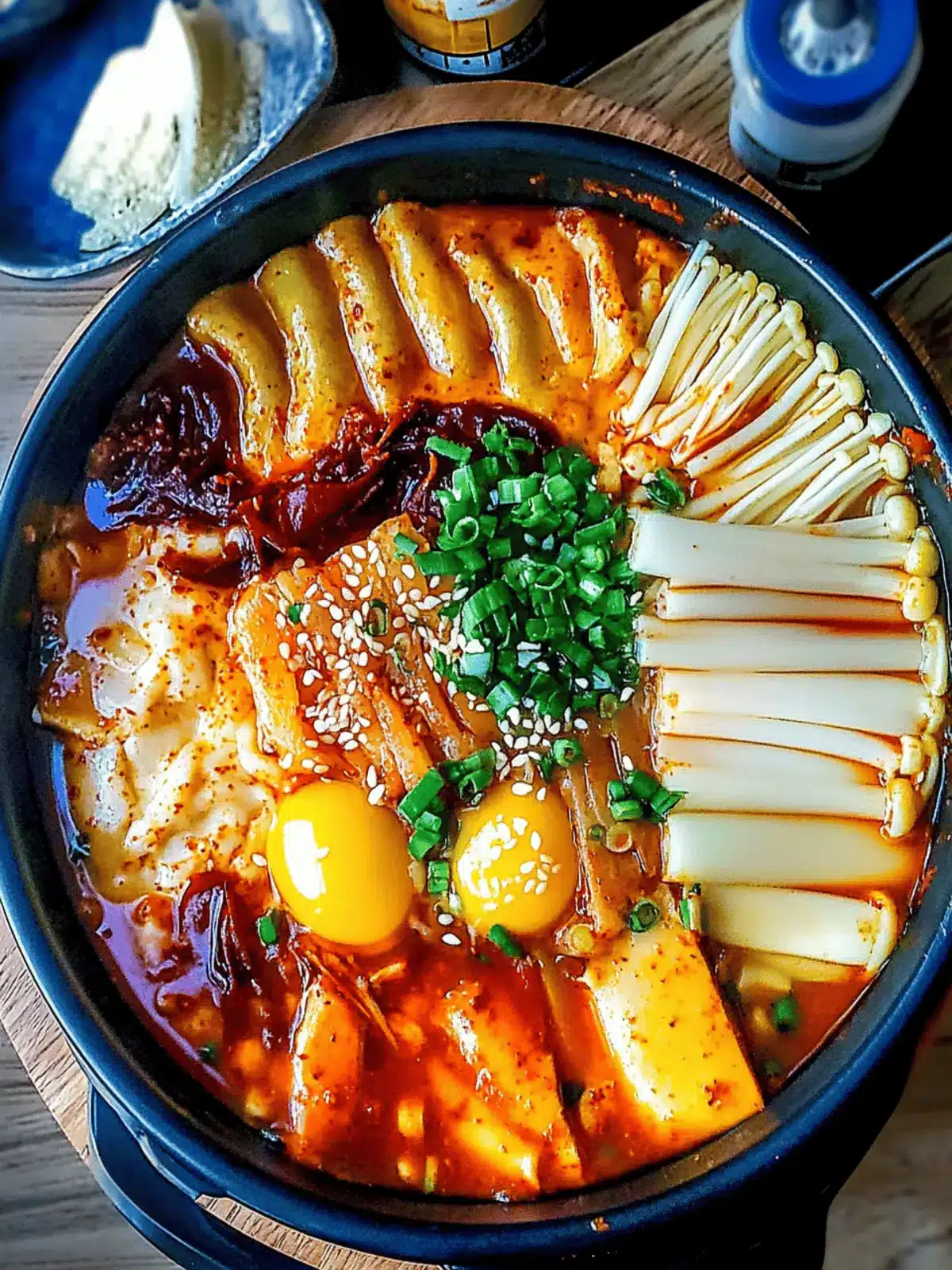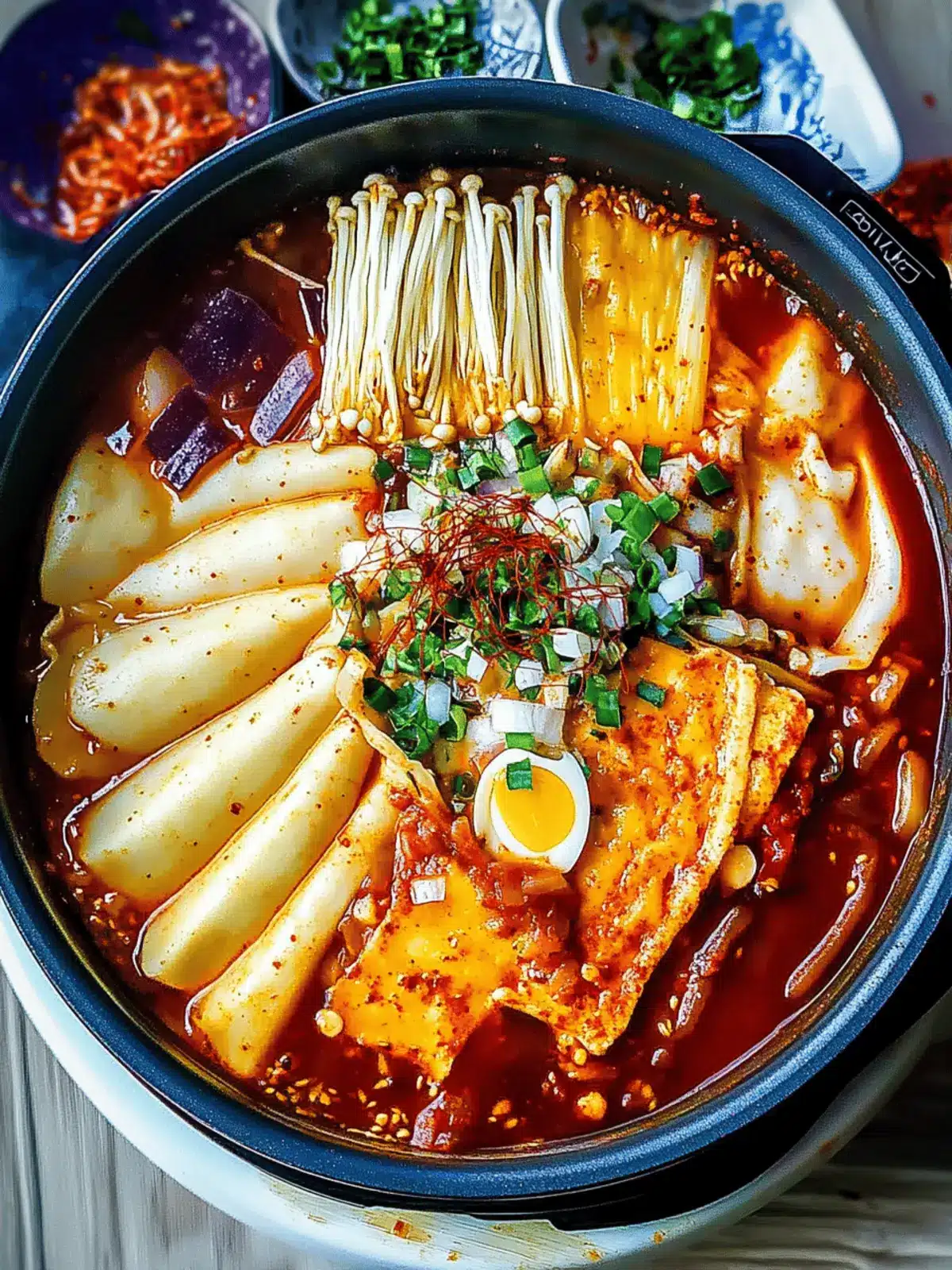On chilly evenings when you crave something hearty and satisfying, Budae Jjigae (Korean Army Stew) emerges as the perfect answer. The first time I tasted this vibrant dish, I was taken aback by the explosion of flavors and sheer comfort it offers—it’s like a warm hug in a bowl! Picture this: tender noodles floating in a spicy broth, filled with savory proteins and vegetables that you can customize based on what you have in your kitchen.
This quick and easy recipe not only showcases the beauty of Korean cuisine but also reflects its resourcefulness, born from a time when ingredients were sparse. With just a little prep and a mere 15 minutes of cooking, you’ll be on your way to impressing family or friends with a dish that feels luxurious but is effortlessly achievable. Ready to make your own bubbling pot of joy? Let’s dive into this delightful stew that promises to tantalize the taste buds and warm the soul!
Why is Budae Jjigae (Korean Army Stew) Unique?
Hearty Comfort: This stew brilliantly combines flavors and textures, offering a warming dish that feels like a cozy embrace.
Flexible Ingredients: You can easily swap in any ingredients you have on hand, making it a perfect way to use up leftovers.
Quick Cooking Time: With only 10 minutes of prep and 15 minutes of cooking, it’s a speedy meal that fits any weeknight schedule.
Party-Ready: This crowd-pleaser is ideal for gatherings, guaranteed to impress your guests with its vibrant presentation and rich taste.
Rich Cultural Heritage: Cooking Budae Jjigae not only fills your belly but also connects you to its fascinating history, showcasing Korean ingenuity in the face of scarcity.
Dive into this delightful recipe and savor the experience of making something both delicious and meaningful!
Budae Jjigae Ingredients
• For the Stew Base
- Firm Tofu – Provides protein and a soft texture; can substitute with tempeh or omit for a lighter version.
- Canned Meat/Spam – Adds umami and richness; substitute with any canned meat like chicken or turkey.
- Sausages – Contributes heartiness; use any preference, like hotdogs or vegan sausages for a meat-free option.
- Onion – Adds aromatic sweetness; any type of onion can be used.
- Green Onions – For freshness and a mild onion flavor; can substitute with chives.
- Seafood Mushrooms/Enoki Mushrooms – Adds texture and umami; substitute with button or shiitake mushrooms if unavailable.
• For the Flavor
- American/Cheddar Cheese – Provides creaminess; use any melting cheese like mozzarella.
- Kimchi – Infuses flavor and tanginess; any homemade or store-bought kimchi works.
- Kimchi Juice – Enhances the kimchi flavor; can be skipped if not available.
- Instant Noodle – The main starch component; any type of instant noodles can be used.
- Chicken Broth/Water – Base for the stew; use vegetable broth for a vegetarian option.
- Gochujang – Adds spice and depth; adjust to taste or use sambal oelek as a substitute.
- Light Soy Sauce – Provides saltiness; use tamari for a gluten-free option.
- Sugar – Balances the heat; substitute with honey or agave syrup.
- Gochugaru – A key ingredient for heat; adjust based on preference.
- Garlic – Enhances flavor depth; fresh or powdered can be used.
Discover the joy of preparing Budae Jjigae (Korean Army Stew), a balancing act of flavors and ingredients that can easily adapt to your pantry’s offerings!
How to Make Budae Jjigae
-
Mix the Sauce: In a bowl, whisk together gochujang, soy sauce, sugar, gochugaru, and garlic until well combined. This blend is essential for that spicy, savory depth.
-
Arrange Ingredients: Neatly place the tofu, Spam, sausages, onion, mushrooms, and kimchi in a shallow pot, creating a circular pattern. Make sure the kimchi and green onions sit in the center for visual appeal.
-
Add the Sauce: Pour the prepared sauce mixture directly into the center of the arranged ingredients, then add the chicken broth. This will infuse all the flavors beautifully as it cooks.
-
Simmer the Stew: Bring the pot to a simmer over medium heat, cover it, and cook for about 6-8 minutes. This step allows the ingredients to meld and soften.
-
Cook the Noodles: Introduce the instant noodles into the center of the pot, continuing to cook for an additional 3-4 minutes. Stir gently until the noodles are perfectly tender and absorb the rich broth.
-
Serve with Toppings: Finish by adding a layer of cheese on top, then garnish with green onions and sesame seeds. Serve hot, enjoying that comforting aroma wafting through your kitchen!
Optional: Add a drizzle of sesame oil for an extra touch of flavor.
Exact quantities are listed in the recipe card below.
How to Store and Freeze Budae Jjigae
-
Room Temperature: It’s best not to leave Budae Jjigae at room temperature for longer than 2 hours to maintain safety and flavor.
-
Fridge: Store leftovers in an airtight container for up to 3 days. Though delicious, be aware that the noodles may become mushy over time.
-
Freezer: You can freeze Budae Jjigae for up to 2 months. For best results, separate the broth and noodles before freezing.
-
Reheating: When ready to enjoy again, gently reheat on the stove over low heat, adding a splash of water if needed to revive the broth.
Budae Jjigae (Korean Army Stew) Variations
Ready to mix things up? Explore these delightful alternatives and substitutions to make your Budae Jjigae truly your own!
- Dairy-Free: Omit the cheese or use a nut-based cheese for a creamy touch without dairy.
- Spicy Kick: Add extra gochugaru or sliced fresh peppers for those who love the heat.
- Vegetarian Treat: Substitute all meat with chickpeas and mushrooms; add nutrient-rich vegetables for a wholesome twist.
- Noodle Alternatives: Try rice noodles or udon for a different texture that pairs beautifully with the broth.
- Umami Boost: Include dried mushrooms or a dash of miso paste to deepen the savory flavors of the stew.
- Savory Sweetness: A tad more sugar or a sprinkle of brown sugar enhances the balance of flavors without overpowering the spice.
- Smoky Flavor: Add smoked sausage or a touch of liquid smoke for a rich, smoky taste that will elevate your dish.
- Fresh Herbs: Experiment with fresh basil or cilantro for a burst of freshness and aromatic flair to brighten each bowl.
Embrace these variations, and let each simmering pot tell a unique culinary story of comfort and warmth!
What to Serve with Budae Jjigae (Korean Army Stew)?
To elevate your meal experience, discover delightful sides that harmonize beautifully with the savory warmth of Budae Jjigae.
-
Steamed Rice: Acts as the perfect base to soak up the spicy broth, offering a comforting balance to the flavors.
-
Korean Pickled Vegetables: These tangy sides provide a refreshing crunch, cutting through the richness of the stew while adding an extra layer of taste.
-
Kimchi Pancakes: Crispy and savory, these pancakes are a wonderful pairing that echoes the kimchi already in the stew for a delightful flavor connection.
-
Fresh Salad: A light, crunchy salad made with crisp greens and a zesty dressing brings brightness to the meal, offering a fresh contrast.
-
Korean Fried Chicken: Juicy and crispy, this indulgent treat adds a satisfying crunch with a fiery kick that complements the stew’s bold flavors.
-
Cold Beer: A chilled beer, especially a Korean lager, enhances the meal’s rich and spicy notes while refreshing your palate.
-
Fruit Dessert: End your meal on a light note with seasonal fruit or a fruit salad, balancing the heat of Budae Jjigae with natural sweetness.
These side dishes not only enhance the enjoyment of your Korean Army Stew but also create a memorable dining experience everyone will appreciate!
Expert Tips for Budae Jjigae
- Ingredient Flexibility: Make substitutions based on what you have in your pantry to create a customized Budae Jjigae everyone will love.
- Watch the Timing: Avoid overcooking by keeping an eye on the instant noodles; they cook quickly and can become mushy if left too long.
- Flavor Balance: Taste your stew before serving; adjust the spice by adding more gochujang or sugar to reach your preferred heat level.
- Broth Base Choice: Use a mix of chicken broth and water for depth, or opt for vegetable broth for a vegetarian-friendly Budae Jjigae.
- Heating Up Leftovers: When reheating, add a bit of water to prevent the noodles from getting too soft; enjoy your comforting meal again!
Make Ahead Options
Budae Jjigae (Korean Army Stew) is an excellent choice for meal prep, saving you valuable time on busy weeknights. You can prepare the sauce (gochujang, soy sauce, sugar, gochugaru, and garlic) up to 24 hours in advance and store it in an airtight container in the refrigerator. Additionally, chop and arrange the vegetables, tofu, canned meat, and sausages in your pot the night before, ready to go. Just remember to cover it tightly to maintain freshness. When you’re ready to enjoy, simply pour in the broth, bring to a simmer, add the instant noodles, and cook as directed. You’ll have all the comforting flavors of Budae Jjigae without the hassle!
Budae Jjigae (Korean Army Stew) Recipe FAQs
What is the best way to select ripe ingredients for Budae Jjigae?
Absolutely! When choosing vegetables and proteins, look for firm, vibrant vegetables without dark spots or bruising. For the tofu, select packages with the closest expiration date, as this ensures freshness. For kimchi, choose varieties with a well-balanced tang; if it’s mushy or overly pungent, it might not be as enjoyable in your stew!
How do I store leftovers of Budae Jjigae?
Very simply! Leftover Budae Jjigae can be stored in an airtight container in the refrigerator for up to 3 days. However, keep in mind that the noodles may soften further over time. If you’d like them to retain their texture, consider removing them before storing and adding fresh noodles when reheating.
Can I freeze Budae Jjigae?
Yes, you can freeze Budae Jjigae! For optimal results, separate the broth and noodles before freezing. Store the broth in a freezer-safe container for up to 2 months, and keep the noodles in a separate bag. When ready to enjoy, thaw the broth overnight in the refrigerator. Then, reheat it on the stove, adding the noodles and any fresh ingredients you’d like.
What should I do if my Budae Jjigae turns out too spicy?
If you find that your stew is too spicy, don’t worry! You can balance out the heat by adding a bit of sugar or honey to counteract the spice. For a creamier texture, stirring in a splash of coconut milk or an extra layer of cheese can help mellow the intensity. Always taste as you adjust—slowly is best!
Can I make a vegetarian version of Budae Jjigae?
Absolutely! To create a vegetarian Budae Jjigae, simply omit the canned meat and sausages, using extra firm tofu and a variety of vegetables such as bell peppers or zucchini instead. Use vegetable broth as the base and ensure your kimchi is vegan-friendly if that’s a dietary concern. Don’t hesitate to experiment with plant-based protein sources to make it your own!

Budae Jjigae: Wholesome Korean Army Stew for Cozy Nights
Ingredients
Equipment
Method
- Mix the Sauce: In a bowl, whisk together gochujang, soy sauce, sugar, gochugaru, and garlic until well combined.
- Arrange Ingredients: Neatly place the tofu, Spam, sausages, onion, mushrooms, and kimchi in a shallow pot, creating a circular pattern.
- Add the Sauce: Pour the prepared sauce mixture directly into the center of the arranged ingredients, then add the chicken broth.
- Simmer the Stew: Bring the pot to a simmer over medium heat, cover it, and cook for about 6-8 minutes.
- Cook the Noodles: Introduce the instant noodles into the center of the pot, cooking for an additional 3-4 minutes.
- Serve with Toppings: Finish by adding cheese, garnish with green onions and serve hot!








